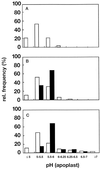Apoplastic pH and Fe(3+) reduction in intact sunflower leaves
- PMID: 10594095
- PMCID: PMC59475
- DOI: 10.1104/pp.121.4.1069
Apoplastic pH and Fe(3+) reduction in intact sunflower leaves
Abstract
It has been hypothesized that under NO(3)(-) nutrition a high apoplastic pH in leaves depresses Fe(3+) reductase activity and thus the subsequent Fe(2+) transport across the plasmalemma, inducing Fe chlorosis. The apoplastic pH in young green leaves of sunflower (Helianthus annuus L.) was measured by fluorescence ratio after xylem sap infiltration. It was shown that NO(3)(-) nutrition significantly increased apoplastic pH at distinct interveinal sites (pH >/= 6.3) and was confined to about 10% of the whole interveinal leaf apoplast. These apoplastic pH increases presumably derive from NO(3)(-)/proton cotransport and are supposed to be related to growing cells of a young leaf; they were not found in the case of sole NH(4)(+) or NH(4)NO(3) nutrition. Complementary to pH measurements, the formation of Fe(2+)-ferrozine from Fe(3+)-citrate was monitored in the xylem apoplast of intact leaves in the presence of buffers at different xylem apoplastic pH by means of image analysis. This analysis revealed that Fe(3+) reduction increased with decreasing apoplastic pH, with the highest rates at around pH 5. 0. In analogy to the monitoring of Fe(3+) reduction in the leaf xylem, we suggest that under alkaline nutritional conditions at interveinal microsites of increased apoplastic pH, Fe(3+) reduction is depressed, inducing leaf chlorosis. The apoplastic pH in the xylem vessels remained low in the still-green veins of leaves with intercostal chlorosis.
Figures






References
-
- Aktas M, Van Egmond M. Effect of nitrate nutrition on Fe utilization by an Fe-efficient and an Fe-inefficient soybean cultivar. Plant Soil. 1979;51:257–274.
-
- Brown JC. Mechanism of iron uptake by plants. Plant Cell Environ. 1978;1:249–257.
-
- Brüggemann W, Maas-Kantel K, Moog PR. Iron uptake by leaf mesophyll cells: the role of the plasma membrane-bound ferric-chelate reductase. Planta. 1993;190:151–155.
-
- Brüggemann W, Moog PR. NADH-dependent Fe3+-EDTA and oxygen reduction by plasmamembrane vesicles from barley roots. Physiol Plant. 1989;75:245–254.
LinkOut - more resources
Full Text Sources
Miscellaneous

